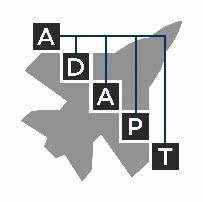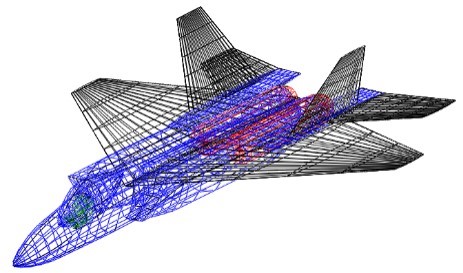


CREATE-AV Kestrel calculations of an F-16 and boom while maneuvering in refueling position behind a notional tanker aircraft. Instantaneous vorticity isosurfaces colored by pressure are shown. The simulations required ~2000 compute cores and were accomplished at the AFRL DSRC.
CREATE-AV (Air Vehicles)
The CREATE-AV project is tasked to develop, deploy, and support a set of multi-disciplinary, physics-based simulation software products for the engineering workforces, supporting air vehicle acquisition programs of the services. These products are designed to exploit the capabilities of next-generation computational resources to decrease the acquisition lifecycle costs of air vehicles and support a paradigm shift to a reliance on virtual testing instead of physical testing as the primary source of decision data. The importance of physical tests is not diminished in any way, but rather the resources are focused on validating the digital model and performance in key areas of the flight envelope. Streamlined engineering workflows and computational physics models enable the detection of design flaws and performance anomalies early in aircraft development by both government and industry professionals. The CREATE-AV software suite includes Kestrel (fixed-wing), Helios (rotary wing), and ADAPT (conceptual design) and supports multiple key DoD initiatives including digital engineering transformation, hypersonic vehicle development and defense, aircraft modernization, and workforce development.
 Kestrel is the fixed-wing simulation tool of the CREATE Air Vehicles
project (CREATE-AV). It allows for high-fidelity simulations coupling aerodynamics,
thermochemisty, structural dynamics and thermodynamics, propulsion, and flight
controls. All DoD aircraft types are supported across flow regimes ranging from
incompressible to hypersonic speeds. Kestrel includes a user interface (KUI),
which serves as the main "face" to the user to intuitively build complex
simulations, and an execution engine that serves as a flexible "message broker"
for all computational components during runtime. The unique architecture allows
for users to incorporate custom or proprietary capabilities into the simulation
through the Software Development Kit (SDK).
Kestrel is the fixed-wing simulation tool of the CREATE Air Vehicles
project (CREATE-AV). It allows for high-fidelity simulations coupling aerodynamics,
thermochemisty, structural dynamics and thermodynamics, propulsion, and flight
controls. All DoD aircraft types are supported across flow regimes ranging from
incompressible to hypersonic speeds. Kestrel includes a user interface (KUI),
which serves as the main "face" to the user to intuitively build complex
simulations, and an execution engine that serves as a flexible "message broker"
for all computational components during runtime. The unique architecture allows
for users to incorporate custom or proprietary capabilities into the simulation
through the Software Development Kit (SDK).

Unsteady simulation of C-17 aircraft using CREATE-AV Kestrel with integrated F117 0-D engine models to add propulsion effects. This capability was used to investigate techniques for paratroopers to exit the C-17 through the side door. Subsequent simulations included 6DOF modeling of the paratrooper with integrated contact/collision effects.
 Helios is a high-fidelity multi-disciplinary computational analysis
platform for rotorcraft aeromechanics applications, supporting Army, Navy,
and Air Force rotorcraft acquisition programs of record. Helios handles aerodynamics
solutions in an innovative manner, using a dual-mesh paradigm: unstructured meshes in
the near-body region and solution-adapting Cartesian meshes in the off-body region.
Helios includes a preprocessor component, which handles mesh assembly and
partitioning, an intuitive GUI for complex job setup (HUI), and the runtime
environment to execute the simulation.
Helios is a high-fidelity multi-disciplinary computational analysis
platform for rotorcraft aeromechanics applications, supporting Army, Navy,
and Air Force rotorcraft acquisition programs of record. Helios handles aerodynamics
solutions in an innovative manner, using a dual-mesh paradigm: unstructured meshes in
the near-body region and solution-adapting Cartesian meshes in the off-body region.
Helios includes a preprocessor component, which handles mesh assembly and
partitioning, an intuitive GUI for complex job setup (HUI), and the runtime
environment to execute the simulation.

CREATE-AV Helios was used to perform flow-field simulations of the Marines' CH-53K rotorcraft which was experiencing Exhaust Gas Reingestion (EGR) in ground effect. The high-fidelity computational model ran on parallel high performance computer systems and enabled engineers to assess over 135 different design options. Ultimately, the team narrowed down to 2 manufactured exhaust ducts which were flight tested and found to mitigate the EGR issues.
 ADAPT (Aircraft Design, Analysis, Performance, and Trade-space) is
CREATE-AV's fixed-wing aircraft conceptual design framework. ADAPT allows
aircraft designers to easily integrate and use multi-disciplinary tools in
a common framework, explore the aircraft design trade-space, and leverage
HPC resources at the conceptual design stage.
ADAPT (Aircraft Design, Analysis, Performance, and Trade-space) is
CREATE-AV's fixed-wing aircraft conceptual design framework. ADAPT allows
aircraft designers to easily integrate and use multi-disciplinary tools in
a common framework, explore the aircraft design trade-space, and leverage
HPC resources at the conceptual design stage.
ADAPT is comprised of three major pieces: (1) the extensible ADAPT data structure, which provides the common framework for integrating multi-disciplinary tools, (2) the ADAPT GUI, which enables conceptual designers to easily set inputs, document work, and analyze results, and (3) the ADAPT execution engine, which runs the integrated multi-disciplinary toolset on desktop or HPC machines.

Parameterized design geometry produced by ADAPT’s integration with OpenVSP. ADAPT integrates with geometry tools like OpenVSP and ESP to allow GUI based multidisciplinary design, analysis, and optimization (MDAO) on both desktop and HPC resources.
Requesting Access
To request access to any of the above software, please visit our Contact page.
